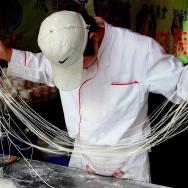A rare mineral inside the teeth of a large mollusk found along rocky coastlines led to a bio-inspired ink for 3D printing and may also one day be used in the emerging field of soft robotics, according to researchers who made the discovery while working at Argonne National Laboratory, a U.S. Department of Energy national lab which is affiliated with the University of Chicago.
A research team from Northwestern University discovered an iron mineral, called santabarbaraite, which previously was only documented in rocks, inside the teeth of a kind of mollusk called a chiton. The finding helped researchers understand how the whole chiton tooth—not just the ultrahard, durable cusp—is designed to endure grazing on rocks to feed.
The discovery led to using this mineral to create an ink that can be used for 3D printing of durable materials. The ink is for composites that have hardness and stiffness in the range of such materials as concrete, brick, glass, carbon fiber reinforced plastics or stainless steel. In the future, it could be used in the emerging soft robotics field, which includes new technologies ranging from space devices for NASA to prosthetics for humans.
A surprise inside a mollusk
The rare mineral was discovered inside the gumboot chiton (Cryptochiton stelleri)—nicknamed the “wandering meatloaf”—with the use of Argonne’s Advanced Photon Source, a large accelerator which produces ultrabright x-rays that can penetrate thick samples of material.
Santabarbarite had only previously been observed in geological specimens in very tiny amounts, and had never before been seen in a biological context—so the scientists were surprised and suspicious at first.
But the group used many different X-ray methods at the Advanced Photon Source, and they all pointed to this same unusual mineral, said Matt Newville, a University of Chicago research associate professor and beamline scientist at the university’s Geo Soil Enviro Consortium for Advanced Radiation Sources (GSECARS).
Santabarbaraite has high water content, which makes it strong with low density.
Linus Stegbauer of Northwestern, the first author of the study, challenged himself to recreate this material but at a larger scale. To this end, he designed an ink for 3D printing. Stegbauer developed a reactive ink comprising iron and phosphate ions mixed into a biopolymer derived from the chitin. The Northwestern team found that the ink printed well when mixed immediately before printing.
Scientists think it could have many uses. “Just use your imagination,” said Northwestern’s Derk Joester, one of the researchers and an associate professor of materials science and engineering in Northwestern’s McCormick School of Engineering.
X-rays mark the mineral
Two different X-ray methods provided a detailed and accurate determination of the mineral’s properties. It was exactly what the team required to make the discovery, said Joester.
“Another amazing part of this work is that at the Advanced Photon Source we have all of these very sophisticated instruments that are the result of decades or even centuries of steady scientific innovation,” said Newville.
“As we use the latest technological achievements, we continue to discover new and amazing things in nature. Whether that's the molecular structure of the spike protein in SARS coronavirus or that these ancient mollusks can synthesize these very hard materials, we're still learning chemistry and material science,” he said.
Joester’s team collaborated with Alp to use the Advanced Photon Source, and worked with Paul Smeets, a postdoc working with Joester, to use transmission electron microscopy at Northwestern’s Atomic and Nanoscale Characterization and Experiment (NUANCE) Center.
Citation: “Persistent polyamorphism in the chiton tooth: From a new biomineral to inks for additive manufacturing.” Stegbauer et al, Proceedings of the National Academy of Sciences, July 9, 2021.
Funding: National Science Foundation, National Institutes of Health, Air Force Research Laboratory, Deutsche Forschungsgemeinschaft, U.S. Department of Energy.
—Adapted from a story by Anna Marie Tomczyk and Amanda Morris published by Argonne National Laboratory.

